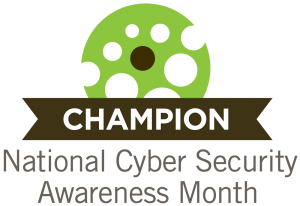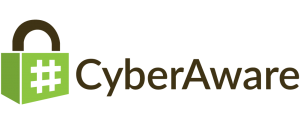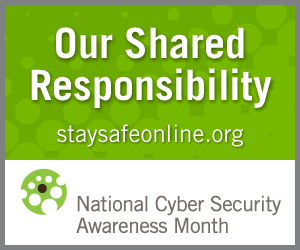Happy National Cyber Security Awareness Month
Happy National Cyber Security Awareness Month (NCSAM) 2017! NDISAC is very excited to celebrate this year as an official NCSAM Champion.
NCSAM is celebrated every October by raising awareness and ensuring safe practices online. The month is dedicated to continuing cyber education and keeping the digital world secure. NCSAM is also a great time for organizations to review cybersecurity policies, assess security preparedness and educate employees about cybersecurity responsibilities.

Joining the NDISAC is one of the best ways organizations can protect themselves and their employees against cyber and physical threats and vulnerabilities while taking an active stance in safeguarding our nation’s critical infrastructure. So this October, fill our an NDISAC membership inquiry to learn how you can join the NDISAC!
For NCSAM 2017, let’s try to raise awareness, review current security plans, and figure out ways to become safe and secure online. During October, NDISAC will recognize the month with through several blog posts discussing the NCSAM themes and other cybersecurity issues. Stay tuned and visit our blog often throughout NCSAM!

About NCSAM
NCSAM was launched in 2004 by the U.S. Department of Homeland Security (DHS) and NCSA in an effort to create a safer and more secure online environment for all. Since 2004, NCSAM has grown exponentially – reaching over 5.4 billion people last year. 2017 marks the 14th year of National Cyber Security Awareness Month.
NCSAM 2017 also marks the 7th anniversary of the STOP. THINK. CONNECT.™ campaign. Each year, NCSAM highlights the overall message of STOP. THINK. CONNECT.™ and the capstone concepts of the campaign.
NCSAM Themes for 2017:
NCSAM focuses on different themes for each week in October. Below are the 5 different themes and information about each from the NCSA website:
Week 1: Oct. 2-6
STOP. THINK. CONNECT.™: Simple Steps to Online Safety
Staying safe and secure online is our shared responsibility. Here is easy-to-follow, actionable advice for everyone. STOP: make sure security measures are in place. THINK: about the consequences of your actions and behaviors online. CONNECT: and enjoy the internet.
It is critical for anyone using the internet to continually learn about and consistently practice good cybersecurity habits. To better protect yourself, you should secure your home networks and mobile devices and take the time to learn how to use the internet more safely, securely and responsibly. Week 1 will address the top consumer cyber concerns, provide simple steps to protect against these concerns and teach you what to do if you fall victim to cybercrime.
Week 2: Oct. 9-13
Cybersecurity in the Workplace Is Everyone’s Business
Whatever your place of business ‒ whether it’s a large or small organization, healthcare provider, academic institution or government agency – creating a culture of cybersecurity from the breakroom to the board room is essential and a shared responsibility among all employees.
Every organization needs a plan for employee education, training and awareness that emphasizes risk management, resistance and resilience. Week 2 will showcase how businesses of all types can protect themselves, their employees and their customers against the most common cyber threats. The week will also look at resources to help organizations strengthen their cyber resilience, including the National Institute of Standards and Technology Cybersecurity Framework.
Week 3: Oct. 16-20
Today’s Predictions for Tomorrow’s Internet
Take a look into our future through the lens of the connected internet and identify strategies for security, safety and privacy while leveraging the latest technology. With the explosion of digital interconnectivity, it is critical to explore everyone’s role in protecting our cyber ecosystem.
Smart cities, connected healthcare devices, digitized records and smart cars and homes have become our new reality. Week 3 will remind you that your personal data is the fuel that makes smart devices work. While there are tremendous benefits of massive interconnectivity, it is critical to understand how to use cutting-edge technology in safe and secure ways.
Week 4: Oct. 23-27
The Internet Wants You: Consider a Career in Cybersecurity
A key risk to our economy and security is the shortage of cybersecurity professionals to protect our extensive networks. Growing the next generation of a skilled cybersecurity workforce ‒ as well as training those already in the workforce ‒ is a starting point to building stronger defenses.
According to a study by the Center for Cyber Safety and Education, by 2022, there will be a shortage of 1.8 million information security workers. It is essential that we graduate students entering the workforce to fill the vast number of positions available and use technology, safely, securely, ethically and productively. Week 4 will encourage students and professionals to explore cybersecurity as a viable and rewarding profession. Key influencers – like parents, teachers, guidance counselors and state and local officials – will learn more about this growing field and how to engage youth in pursuing cybersecurity careers.
Week 5: Oct. 30-31
Protecting Critical Infrastructure From Cyber Threats
The systems that support our daily lives – such as electricity, financial institutions and transportation – are increasingly dependent upon the internet. Building resilience in critical infrastructure is crucial to our national security.
Week 5 will look at how cybersecurity relates to keeping our traffic lights, running water, phone lines and other critical infrastructure secure. This week is also the transition to November’s Critical Infrastructure Security and Resilience Month, highlighting the tie between cybersecurity and our nation’s critical infrastructure.

